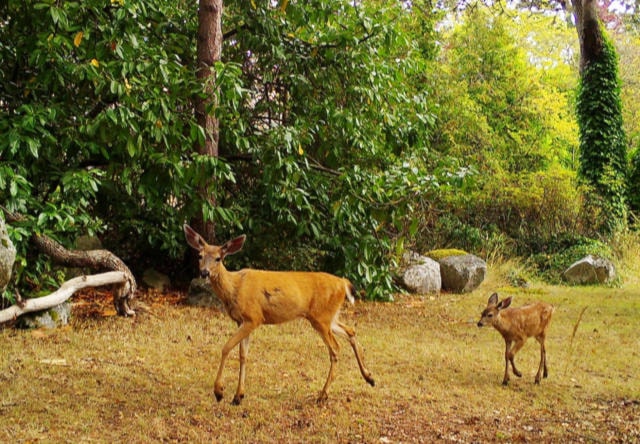Summer in the Capital Region brings more than sunny days. It’s also the start of fawning season – the time you’re more likely to see does with a fawn or two following along, or find a fawn curled up in a corner of your yard or neighbourhood park.
And that means it’s also time to be extra cautious as you drive, cycle and explore, notes Kristy Kilpatrick, from the Urban Wildlife Stewardship Society, which has been working with the Township of Esquimalt on a deer management plan, in addition to pursuing a research and deer contraception program in Oak Bay.
Esquimalt Council has committed to making non-lethal management decisions based on scientific evidence, and with the second of three planned fall deer counts complete, research points to stable numbers from 2017 to 2018, Kilpatrick says.
For the deer that you do see, here are a few tips to remember:
1. DO give deer their space: To avoid conflict with protective deer, as you stroll your neighbourhood or walk your dog, remember that does will often act in a protective manner if you’re near a fawn – even if you can’t see the young animal. DO keep dogs leashed and walking near you, and DON’T release the leash; to the deer, a dog is a predator. If a doe seems to follow you, try changing direction as you may be unknowingly walking toward a hidden fawn.
2. DON’T fawn over fawns: If you find a fawn, leave it alone. Does shelter fawns from predators, leaving for long periods to forage, then returning for fawns to suckle. Because fawns are born without scent, for the first few weeks, does may feed and sleep a considerable distance from the fawn to reduce the chance of attracting predators.
Wildlife centres like the BC SPCA’s WildARC field numerous calls from people who have found an “orphaned” fawn, but typically advise residents to leave it alone – the mother is likely nearby and will return once you leave.
3. DO call WildArc if…: The fawn appears cold, weak, thin, injured, is bleating repetitively, or if the mother has not returned to a seemingly healthy fawn for more than eight hours.
4. DON’T remove a fawn on your own: If you’ve inadvertently handled the animal, rub an old towel on the grass, then gently wipe the fawn down with it to remove human scent.
5. DO reduce your chance of colliding with a deer: Slow down and scan ahead, especially in areas common to deer! Just as you watch for children and pets, keep your eyes on alert, especially at night, and remember, deer are rarely alone – others may follow behind or dart into your path. Headlights can confuse and cause deer to freeze or act unpredictably, while young deer may not recognize vehicles as a threat.
For more tips about living with urban deer, visit uwss.ca.
